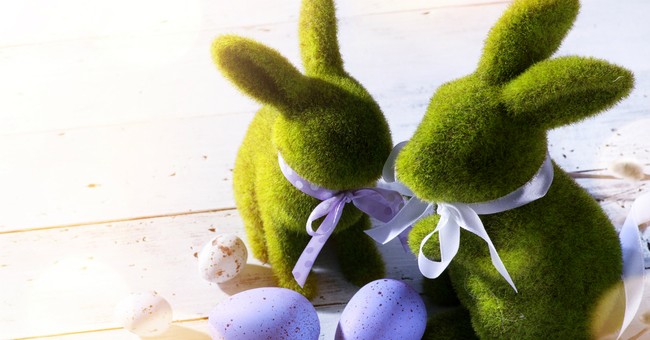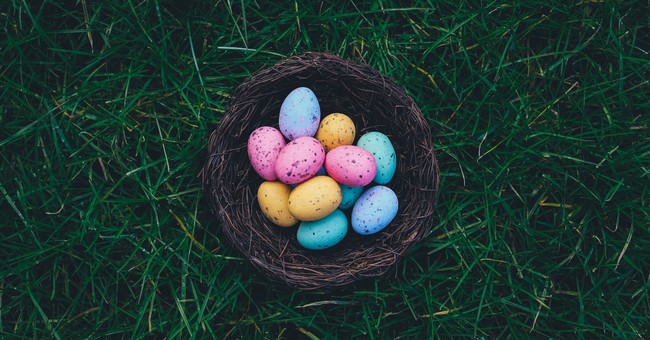Watch Me Rise Again Bible Verse
Table of Contents
- What is Easter?
- Origin of Easter and Offset Celebrated
- When is Easter?
- What Does Easter mean?
- Easter and Passover
- Christian and Heathen Traditions
- Easter Bunny Origin and History
- Easter Eggs Origin and History
What is Easter?
Easter is the celebration of the resurrection of Jesus from the tomb on the third day later his crucifixion. Easter is the fulfilled prophecy of the Messiah who would exist persecuted, die for our sins, and rise on the 3rd solar day (Isaiah 53). Remembering the resurrection of Jesus is a way to renew daily hope that we have victory over sin. According to the New Testament, Easter is three days later the death of Jesus on the cantankerous.
Easter follows a period of fasting called Lent, in which many churches set up bated time for repentance and remembrance. Lent begins on Ash Midweek and ends on Practiced Friday, the day of Jesus' crucifixion. The 40 twenty-four hours flow was established by Pope Gregory 1 using the xl-day pattern of State of israel, Moses, Elijah, and Jesus' time in the wilderness.
The week leading upwardly to Easter is called The Holy Week, or "Passion Week", and includes Palm Sun (the 24-hour interval Jesus entered Jerusalem and was celebrated), Maundy Thursday (the "Last Supper" where Jesus met with his disciples to observe Passover), and Good Friday (when Jesus would be crucified on the cantankerous).
Easter is a very significant engagement within Christianity and is the foundation of the Christian faith. Jesus, the Son of God, fulfilled prophecy and through his death, has given the gift of eternal life in heaven to those who believe in his death and resurrection. Read the entire Biblical account of Resurrection Solar day in Matthew 28, Mark 16, and Luke 24 and more Easter Bible verses at BibleStudyTools.com.
Ready to gear up your centre for this Lent and Easter season? Download our Costless twoscore-Mean solar day Easter Devotional to celebrate and reflect upon Jesus' cede for usa.
Origin of Easter and Beginning Celebrated
The earliest Christians historic the resurrection on the fourteenth of Nisan (our March-April), the appointment of the Jewish Passover. Jewish days were reckoned from evening to evening, so Jesus had celebrated His Last Supper the evening of the Passover and was crucified the day of the Passover. The origin of Easter started with early Christians celebrating the Passover worshiped Jesus as the Paschal Lamb and Redeemer.
The origin of some of the Gentile Christians began celebrating Easter in the nearest Sunday to the Passover since Jesus actually arose on a Sunday. This specially became the case in the western part of the Roman Empire. In Rome itself, unlike congregations celebrated Easter on different days!
Many felt that the date should continue to be based on the timing of the Resurrection during Passover. Once Jewish leaders determined the date of Passover each year, Christian leaders could set the engagement for Easter by figuring three days after Passover.Post-obit this schedule would have meant that Easter would be a different twenty-four hours of the week each year, only falling on a Dominicus one time in a while.
Others believed since the Lord rose on a Sunday and this mean solar day had been set aside every bit the Lord'due south Mean solar day, this was the only possible solar day to celebrate His resurrection.As Christianity drew away from Judaism, some were reluctant to base the Christian celebration on the Jewish calendar.
Constantine wanted Christianity to be totally separated from Judaism and did not want Easter to be celebrated on the Jewish Passover. The Council of Nicea accordingly required the banquet of the resurrection to be celebrated on a Sunday and never on the Jewish Passover. Easter was to be the Sunday later the offset full moon after the spring equinox. Since the date of the vernal equinox changed from year to year, calculating the proper date can be difficult.This is still the method used to decide Easter today, which is why some years nosotros have Easter earlier than other years.
When is Easter this Year?
Easter falls on Sun, April 17, 2022. Easter is celebrated on the Sunday post-obit the get-go full moon, the Pachschal full moon, after the vernal equinox. Since the date of the vernal equinox changed from year to year, calculating the proper date can be difficult. This is notwithstanding the method used to determine Easter today, which is why some years we take Easter earlier than other years. For more details visit: When Is Easter?
- April ix, 2023
- March 31, 2024
- Apr xx, 2025
- Apr 5, 2026
What Does Easter mean?
The origin of the word easter isn't certain.The Venerable Bede, an eighth-century monk, and scholar suggested that the word may have come from the Anglo-Saxon Eeostre or Eastre – a Teutonic goddess of leap and fertility.Recent scholars haven't been able to find whatsoever reference to the goddess Bede mentioned and consider the theory discredited.
Another possibility is the Norse eostur, eastur, or ostara, which meant "the season of the growing sun" or "the season of new birth." The word e comes from the same roots.In this example, easter would be linked to the irresolute of the season.
A more than recent and circuitous caption comes from the Christian background of Easter rather than the infidel.The early Latin name for the calendar week of Easter was hebdomada alba or "white calendar week," while the Sunday after Easter day was called dominica in albis from the white robes of those who had been newly baptized.The give-and-take alba is Latin both for white and dawn. People speaking Sometime High German fabricated a mistake in their translation and used a plural word for dawn, ostarun, instead of a plural for white.From ostarun we get the German Ostern and the English language Easter.
Get your free Easter Prayer and Scripture Guide HERE to reflect on the meaning and importance of Christ's resurrection.
How Does Easter Connect to Passover?
The twenty-four hour period earlier his crucifixion, Jesus observed Passover with his disciples. This result is known as the Concluding Supper. Passover is the time that Jews remembered their freedom and exodus from Egypt. During this Passover banquet, Jesus told his disciples that the bread symbolizes his torso that would be broken and the wine, his blood, which would be poured out for the forgiveness of sins (Matthew 26:17-xxx). The Last Supper is remembered today in churches and religious services through the act of taking Communion and sharing bread and wine to recollect the sacrifice of Jesus.
Jesus was arrested after the Passover meal while he was praying in the Garden of Gethsemane. He was then taken before the Roman Governor, Pontius Pilate, for trial.
Christian and Pagan Traditions
There are many traditions that surround the entire Lent flavour, Holy Week, and Easter Sunday. Generally observed traditions across the earth include the Easter bunny, colored eggs, gift baskets, and flowers. We will dive into specific traditions below in more than detail, but hither are a few more interesting traditions from around the globe:
- In Australia, bunnies are considered pests that ruin crops and land. Aussies celebrate with their native marsupial, the Bibly, which has large ears and a more pointy nose.
- In Poland on Easter Monday, boys effort to soak people with buckets of water. This tradition has is rooted in the baptism of Polich Prince Mieszko on Easter Mon in 996.
- In Greece, the morning time of Holy Sabbatum is known as the almanac "pot throwing" where residents throw pots out of windows. Information technology is a tradition used to mark the beginning of spring and new crops being gathered in new pots.
- In Europe, in that location are large bonfires called Easter Fires that are lit on Easter Sunday into Monday. The Saxon origin is that the fires volition chase abroad winter and Easter will bring bound.
Origin and History of the Easter Bunny

Photograph Credit:©GettyImages/Konstanttin
What is the starting time thing that comes to listen when you retrieve of Easter?As a Christian, the first paradigm might be the cross or the empty tomb.For the general public, a blitz of media images and merchandise on store shelves makes it more likely that the Easter Bunny comes to mind.And so how did a rabbit distributing eggs become a role of Easter?
There are several reasons for the rabbit, or hare, to exist associated with Easter, all of which come through pagan celebrations or beliefs.The most obvious is the hare's fertility. Easter comes during bound and celebrates new life.The Christian meaning of new life through Christ and a full general accent on new life are different, but the ii gradually merged.Whatsoever animals – like the hare – that produced many offspring were easy to include.
The hare is also an aboriginal symbol for the moon.The appointment of Easter depends on the moon.This may have helped the hare to be absorbed into Easter celebrations.
The hare or rabbit's burrow helped the animate being's adoption as part of Easter celebrations.Believers saw the rabbit coming out of its underground home as a symbol for Jesus coming out of the tomb. Perhaps this was some other case of taking a pre-existing symbol and giving information technology a Christian pregnant.
The Easter hare came to America with German immigrants, and the hare's office passed to the mutual American rabbit. Originally children made nests for the rabbit in hats, bonnets, or fancy newspaper boxes, rather than the baskets of today.Once the children finished their nests, they put them in a secluded spot to keep from frightening the shy rabbit.The appealing nests total of colored eggs probably helped the customs to spread.
Dorsum in Southern Germany, the start pastry and candy Easter bunnies became popular at the beginning of the nineteenth century.This custom also crossed the Atlantic, and children all the same consume processed rabbits – specially chocolate ones – at Easter.
Origin and History of Easter Eggs

Photo Credit: Unsplash/ Annie Spratt
Side by side to the Easter bunny, the most familiar symbol is the Easter egg. Like others, the egg has a long pre-Christian history. Again there's no certainty as to why it became associated with Easter.
Many Ancient cultures viewed eggs as a symbol of life.Hindus, Egyptians, Persians, and Phoenicians believed the globe begun with an enormous egg. The Persians, Greeks, and Chinese gave gifts of eggs during spring festivals in celebration of new life all around them.Other sources say people ate dyed eggs at spring festivals in Egypt, Persia, Greece, and Rome. In ancient Druid lore, the eggs of serpents were sacred and stood for life.
Early Christians looked at the connection eggs had to life and decided eggs could be a part of their celebration of Christ's resurrection. In addition, in some areas, eggs were forbidden during Lent; therefore, they were a delicacy at Easter.Since many of the earlier community were Eastern in origin, some speculate that early missionaries or knights of the Cause may take been responsible for bringing the tradition to the West.
In the fourth century, people presented eggs in church to be blessed and sprinkled with holy water. By the twelfth century, the Benedictio Ovorum had been introduced authorizing the special use of eggs on the holy days of Easter. The timing of this blessing would uphold the idea that Crusaders may accept brought the tradition back. Even though eggs had been used previously, the Crusaders may accept made the custom more popular and widespread.
In 1290, Edward I of England recorded a buy of 450 eggs to be colored or covered with gold leafage. He so gave the eggs to members of the royal household.
One time the custom became accustomed, new traditions began to grow up around it.Eggs were dyed red for joy and in retentiveness of Christ'due south blood. Egg rolling contests came to America from England, mayhap as a reminder of the stone being rolled away.
What about the familiar Easter Egg hunt?One source suggested that it grew out of the tradition of High german children searching for subconscious pretzels during the Easter season.Since children were hiding nests for the Easter Bunny to fill with eggs at the same time they were hunting pretzels, it was only a small leap to begin hiding eggs instead.
Meaning of the Easter Lamb
Of all Easter symbols, the lamb is probably the nigh strongly Christian.Other than the fact that lambs are young animals born in springtime, it has no strong ties to pagan traditions.
The lamb comes from the Jewish Passover, where each family killed a lamb as a cede.When Christ became the Passover Lamb for everyone, the lamb became a symbol for His sacrifice.
John 1:29 - "The next solar day John saw Jesus coming toward him and said, "Expect, the Lamb of God, who takes away the sin of the world!"
1 Peter 1:18-21 - "For you lot know that it was not with perishable things such every bit argent or gold that you were redeemed from the empty fashion of life handed down to you lot from your ancestors, but with the precious claret of Christ, a lamb without blotch or defect. He was chosen before the cosmos of the globe, but was revealed in these last times for your sake. Through him you believe in God, who raised him from the dead and glorified him, and so your faith and hope are in God."
New Dress at Easter
New clothes have long been associated with the idea of newness and a fresh showtime.The familiar custom of having new dress for Easter probably began with early Christians wearing new white robes for baptism during Easter Acuity services.Later, the custom expanded to everyone wearing new clothes in celebration of his or her new life in Christ.
Sunrise Services
The familiar sunrise service is a relatively new addition to Easter.A group of immature Moravian men in Hernhut, Saxony held the first recorded sunrise service in 1732.They went to their cemetery called God's Acre at sunrise to worship in memory of the women who went to the tomb early on the starting time Easter morn and discovered it empty.Moravian immigrants brought the custom to America, with the showtime service in the United States held in 1743.
Easter Lilies

Photo Credit: Unplash/ Matt Lewis
The Easter lily is another new addition to Easter celebrations. Throughout the years, painters and sculptors used the white Madonna lily to symbolize purity and innocence, frequently referring to Mary. This lily doesn't force well, and then nurseries couldn't get the blossom to bloom in fourth dimension for Easter. In the 1880s, Mrs. Thomas Sargent brought Bermuda lily bulbs back to Philadelphia. A local nurseryman, William Harris, saw the lilies and introduced them to the merchandise. A more applied consideration was that they were like shooting fish in a barrel to force into bloom in fourth dimension for the Easter season.From there, the Bermuda lily, now the familiar Easter lily, spread throughout the country.
Easter is an important holiday, if not the most significant event in the Christian religion. May God anoint you this Easter and always!
Related :
Easter Prayers
Easter Bible Verses and Scriptures - He is Risen!
Easter Blessings
What is Good Friday
The Resurrection of Jesus - seven Facts to Know and Understand
Sources:
Claire Nowak, 9 Fastinating Easter Traditions from Around the Earth, Readers Digest
Mary Papenfuss, Aussies Are Shunning Bunnies and Embracing the Easter Bibly Instead, Huffington Post
Christianity.com When is Easter?
Excerpted from Holidays & Holy Days, © 2001 by Susan E. Richardson. Published past Majestic Books, 1957 Eastman Ave, Ventura, California, 93003. Used by permission. All rights reserved. You can purchase this book at christianbook.com.
Photo credit: ©Thinkstock/motimeiri
Source: https://www.crosswalk.com/faith/spiritual-life/undertanding-the-history-and-symbols-of-easter-1256039.html
0 Response to "Watch Me Rise Again Bible Verse"
Publicar un comentario